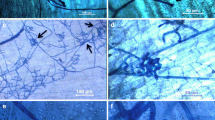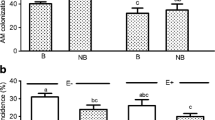Abstract
Muskmelon (Cucumis melo cv. Temprano Rochet) and autumn squash (Cucurbita maxima) seedlings were inoculated either with Acremonium cucurbitacearum or Monosporascus cannonballus, two of the soil-borne fungi implicated in ‘melon collapse’. Inoculation was achieved in two different ways: by growing the plants in pots containing infested soil to study the histological changes produced in the infected tissues using light microscopy and by growing seedlings in Petri dishes together with fungal colonies in order to observe the colonisation of the plant tissues using scanning electron microscopy. Both muskmelon and autumn squash roots infected with A. cucurbitacearum showed a suberised layer in the epidermis and the outermost layers of the parenchymatic cortex, but these symptoms developed earlier in the muskmelon plants. Muskmelon plants infected by this fungus also presented hypertrophy and hyperplasia, which led to a progressive separation of the vascular bundles in the lower stems of the affected plants. This response was not observed in autumn squash during the study. On the other hand, few histological changes were observed in tissues infected with M. cannonballus and only a slight increase in the size of cortical intercellular spaces was noted in the lower stems of muskmelon plants, and infected autumn squash tissues remained free of these symptoms throughout the study. The scanning electron microscope observations revealed that both fungi were able to colonise the tissues of the two host plants which were studied. A. cucurbitacearum colonised the epidermis and cortex of both muskmelon and autumn squash. The hyphae grew both inter- and intracellularly, and the density of the colonisation decreased within the endodermis. The same colonisation of host plants was observed as a result of M. cannonballus infection. The xylem vessel lumina of both muskmelon and autumn squash showed hyphae and tylose formation as a result of both fungal infections. However, non-fungal structures were detected in the hypocotyl vascular tissues. The present study demonstrates that both fungi are capable of infecting the tissues of a species which is resistant (autumn squash) and a species which is susceptible (muskmelon) to melon collapse.








Similar content being viewed by others
References
Aegerter, B. J., Gordon, T. R., & Davis, R. M. (2000). Occurrence and pathogenicity of fungi associated with melon root rot and vine decline in California. Plant Disease, 84, 224–230. doi:10.1094/PDIS.2000.84.3.224.
Agrios, G. N. (1996). Fitopatología. San José, México: Ed. Uteha.
Alcántara, T., Stanghellini, M. E., Kim, D. H., & Rasmussen, S. L. (1998). Tyloses formation in relation to symptom development of vine decline of melon caused by Monosporascus cannonballus. Phytopathology, 88(9), S2.
Alfaro-García, A., Armengol, J., Bruton, B. D., Gams, W., García-Jiménez, J., & Martínez-Ferrer, G. (1996). The taxonomic position of the causal agent of Acremonium collapse of muskmelon. Mycologia, 88(5), 804–808. doi:10.2307/3760975.
Armengol, J. (1997). Aspectos patológicos, epidemiológicos y culturales de Acremonium cucurbitacearum Alfaro-García, W. Gams et J. García-Jiménez. Universidad Politécnica de Valencia. Ph.D. Thesis.
Armengol, J., Sanz, E., Martínez-Ferrer, G., Sales, R., Bruton, B. D., & García-Jiménez, J. (1998). Host range of Acremonium cucurbitacearum, cause of Acremonium collapse of muskmelon. Plant Pathology, 47, 29–35. doi:10.1046/j.1365-3059.1998.00199.x.
Beltrán, R., Vicent, A., Sales, R., García-Jiménez, J., & Armengol, J. (2005). Population dynamics of Monosporascus cannonballus in marsh soils in eastern Spain. European Journal of Plant Pathology, 113(4), 357–365. doi:10.1007/s10658-005-2930-0.
Beltrán, R., Vicent, A., García-Jiménez, J., & Armengol, J. (2007). Quantification of Monosporascus cannonballus ascospores in muskmelon fields in eastern Spain. Journal of Phytopathology, 155, 248–250. doi:10.1111/j.1439-0434.2007.01215.x.
Beltrán, R., Vicent, A., García-Jiménez, J., & Armengol, J. (2008). Comparative epidemiology of Monosporascus root rot and vine decline in muskmelon, watermelon and grafted watermelon crops. Plant Disease, 92(1), 158–163. doi:10.1094/PDIS-92-1-0158.
Benhamou, N., & Garand, C. (2001). Cytological analysis of defense-related mechanisms induced in pea root tissues in response to colonization by non-pathogenic Fusarium oxysporum Fo47. Phytopathology, 91, 730–740. doi:10.1094/PHYTO.2001.91.8.730.
Biernacki, M., & Bruton, B. D. (2001). Quantitative response of Cucumis melo inoculated with root rot pathogens. Plant Disease, 85, 65–70. doi:10.1094/PDIS.2001.85.1.65.
Bruton, B. D., Russo, V. M., García-Jiménez, J., & Miller, M. E. (1998). Carbohydrate partitioning, cultural practices, and vine decline diseases of cucurbits. In J. McCreight (Ed.), Cucurbitaceae 98 (pp. 189-200). U.S.A: American Society of Horticultural Science Press, Alexandria.
Bruton, B., García-Jiménez, J., Armengol, J., & Popham, T. (2000). Assessment of virulence of Acremonium cucurbitacearum and Monosporascus cannonballus on Cucumis melo. Plant Disease, 84, 907–913. doi:10.1094/PDIS.2000.84.8.907.
Cohen, R., Pivonia, S., Burger, Y., Edelstein, M., Gamliel, A., & Katan, J. (2000). Toward integrated management of Monosporascus Wilt of melon in Israel. Plant Disease, 84(5), 496–505. doi:10.1094/PDIS.2000.84.5.496.
Cohen, R., Burger, Y., Horev, C., Potat, A., & Edelstein, M. (2005). Perfomance of Galia-type melons grafted onto Cucurbita rootstock in Monosporascus cannonballus-infested and non-infested soils. The Annals of Applied Biology, 146, 381–387. doi:10.1111/j.1744-7348.2005.040010.x.
Dhingra, O. D., & Sinclair, J. B. (1985). Basic plant pathology methods. Boca Ratón, Florida: CRC Press, Inc.
Dias, R. C. S., Picó, B., Espinós, A., & Nuez, F. (2004). Resistance to melon vine decline derived from Cucumis melo subsp. agrestis: genetic analysis of root structure and root response. Plant Breeding, 123, 1–7. doi:10.1046/j.1439-0523.2003.00944.x.
Drew, M. C., Jackson, M. B., & Giffard, S. (1979). Ethylene-promoted adventitious rooting and development of cortical air spaces (aerenchyma) in roots may be adaptative responses to flooding in Zea mays L. Planta, 147, 83–88. doi:10.1007/BF00384595.
García-Jiménez, J., Velázquez, M. T., Jordá, C., & Alfaro-García, A. (1994). Acremonium species as the causal agent of muskmelon collapse in Spain. Plant Disease, 78(4), 416–419.
García-Jiménez, J., Armengol, J., Sales, R., Jordá, C., & Bruton, B. D. (2000). Fungal pathogens associated with melon collapse in Spain. EPPO Bulletin, 30, 169–173. doi:10.1111/j.1365-2338.2000.tb00873.x.
Garret, S. D. (1970). Pathogenic root-infecting fungi. London, UK: Cambridge University Press.
Johansen, D. A. (1940). Plant Microtechnique. New York: McGraw Hill Book Company.
Martyn, R. D., & Miller, M. E. (1996). Monosporascus root rot and vine decline: an emerging disease of melon worldwide. Plant Disease, 80(7), 716–725.
Mertely, J. C., Martyn, R. D., Miller, M. E., & Bruton, B. D. (1991). Role of Monosporascus cannonballus and other fungi in a root rot/ vine decline disease in muskmelon. Plant Disease, 75(11), 1133–1137.
Mertely, J. C., Martyn, R. D., Miller, M. E., & Bruton, B. D. (1993). An expanded host range for the muskmelon pathogen Monosporascus cannonballus. Plant Disease, 77(7), 667–673.
Miguel, A., Maroto, J. V., San Bautista, A., Baixauli, C., Cebolla, V., Pascual, B., López, S., & Guardiola, J. L. (2004). The grafting of triploid watermelon is an advantageous alternative to soil fumigation by methyl bromide for control of Fusarium wilt. Scientia Horticulturae, 103(1), 9–17. doi:10.1016/j.scienta.2004.04.007.
Olivain, C., & Alabouvette, C. (1999). Process of tomato root colonization by a pathogenic strain of Fusarium oxysporum f. sp. lycopersici in comparison with a non-pathogenic strain. The New Phytologist, 141, 497–510. doi:10.1046/j.1469-8137.1999.00365.x.
Pivonia, S., Cohen, R., Kafkafi, U., Ben Ze’ev, I. S., & Katan, J. (1997). Sudden wilt of melons in Southern Israel: fungal agents and relationship with plant development. Plant Disease, 81, 1264–1268. doi:10.1094/PDIS.1997.81.11.1264.
Pivonia, S., Cohen, R., Katan, J., & Kigel, J. (2002). Effect of fruit load on the water balance of melon plants infected with Monosporascus cannonballus. Physiological and Molecular Plant Pathology, 60, 39–49. doi:10.1006/pmpp. 2001.0375.
Pivonia, S., Cohen, R., Cohen, S., Kigel, J., Levita, R., & Katan, J. (2004). Effect of irrigation regimes on disease expression in melon plants infected with Monosporascus cannonballus. European Journal of Plant Pathology, 110, 155–161. doi:10.1023/B:EJPP.0000015341.95455.22.
Pollack, F. G., & Uecker, F. A. (1974). Monosporascus cannonballus an unusual Ascomycete in cantaloupe roots. Mycologia, 66, 346–349. doi:10.2307/3758370.
Šutić, D. D., & Sinclair, J. B. (1991). Anatomy and physiology of diseased plants. Boca Ratón, Florida: CRC Press.
Waugh, M. M., Stanghellini, M. E., & Kim, D. (2001). Scanning electron microscopy of germinated ascospores of Monosporascus cannonballus. Mycological Research, 105(6), 745–748. doi:10.1017/S0953756201004117.
Waugh, M. M., Ferrin, D. M., & Stanghellini, M. E. (2005). Colonization of cantaloupe roots by Monosporascus cannonballus. Mycological Research, 109(11), 1297–1301. doi:10.1017/S0953756205003722.
Zacarías, L., & Lafuente, M. T. (2008). Etileno, ácido abscísico y otros reguladores del desarrollo. In J. Azcón-Bieto & M. Talon (Eds.), Fisiología y bioquímica vegetal. (pp. 445–466) Madrid. Spain: Interamericana McGraw-Hill.
Acknowledgements
This work was funded by grant AGL2000-1809-C03-01 from the Spanish Ministry of Science and Technology. We would like to thank Dr. J. García-Jiménez, Dr. J. Armengol and Dr. R. Beltrán for their expert guidance on the pathological aspects of this research and Dr. J.L. Guardiola for his critical review of the manuscript. The authors also wish to thank the U.P.V Electron Microscopy Service for providing technical assistance with the S.E.M. observations. We would like to thank the R&D&I Linguistic Assistance Office, Universidad Politécnica de Valencia (Spain) for granting financial support for the linguistic revision of this paper.
Author information
Authors and Affiliations
Corresponding author
Rights and permissions
About this article
Cite this article
Alfaro-Fernández, A., García-Luis, A. Colonisation and histological changes in muskmelon and autumn squash tissues infected by Acremonium cucurbitacearum or Monosporascus cannonballus . Eur J Plant Pathol 125, 73–85 (2009). https://doi.org/10.1007/s10658-009-9460-0
Received:
Accepted:
Published:
Issue Date:
DOI: https://doi.org/10.1007/s10658-009-9460-0




